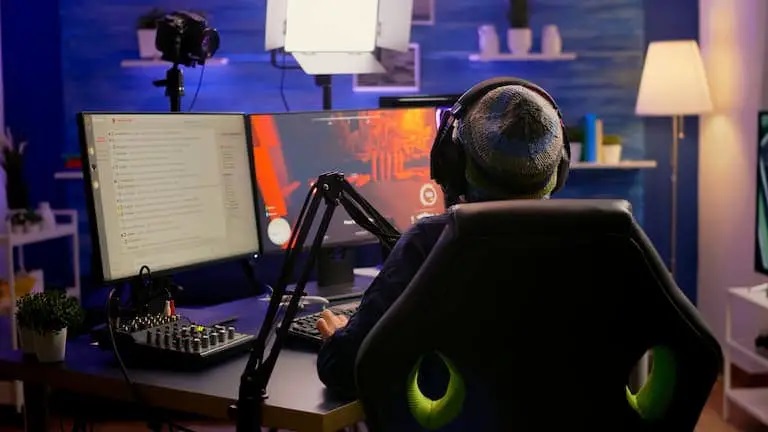Streaming can be a great way to make an income doing something you love. However, it can be difficult to figure out how to get started. You might be wondering whether or not you should use a capture card while streaming.
A streaming PC is a better option than a capture card if you can directly feed the content from the source device to your encoding and broadcasting software. If you can’t achieve this, then a capture card is necessary. A good capture card with an encoder and storage can be a valuable streaming asset.
The rest of this article will expand upon the pros and cons of a streaming PC versus a capture card, so you can make the best decisions for your personal setup and start streaming effectively.

What Is a Streaming PC?
A streaming PC is your broadcasting system, which can also be the content’s source device. However, the source can be a PC, laptop, DSLR, webcam, games console, etc. Thus, you may need a second PC for streaming if the source device lacks the specs.
You cannot stream content directly from a device that cannot operate streaming solutions like Open Broadcast Software (OBS). Because of this, you need a second or separate streaming PC to run softwares like OBS Studio, Streamlabs OBS, Xsplit Gamecaster, or Nvidia Shadowplay.
Suppose you have a reasonably powerful gaming PC, but the specs are not sufficient to play graphics-intensive games and live stream the content simultaneously. In this scenario, you will need a second PC for streaming. This setup is essentially dual PC streaming.
Now, there are two reliable ways to connect your gaming rig or source device to a streaming PC. The latter may also be a laptop and not necessarily a high-end model.
The first option to connect a source device like a camera or gaming rig to a streaming PC is a capture card. The other method is Ethernet-based NewTek NDI (Network Device Interface).
Thus, a streaming PC and capture card is not an either-or scenario in dual system setups. You need both unless you want to work with NewTek NDI or similar solutions.
What Is a Capture Card?
A capture card is a device that transfers audiovisual content from a source to a PC as a passthrough without altering the raw data. The raw audiovisual content is then encoded and made ready for broadcasting and media players by a streaming PC using software.
Technically, a capture card is an intermediary. These devices capture raw data from an input source, i.e., DSLR, PC, laptop, webcam, microphones, and gaming consoles. The capture card then feeds the raw data to a streaming PC that has the encoding and broadcasting software.
In other words, a capture card is not a substitute for a streaming PC. Capture cards cannot run streaming software or broadcast live on Twitch, YouTube, and other platforms. Also, a streaming PC can still receive the raw audiovisual data without a capture card, which I will discuss later.
Using a capture card to stream directly from a gaming PC has no practical benefit. However, you need a capture card to connect consoles or gaming rigs to a streaming PC unless you can use a solution like NewTek NDI.
Furthermore, you do not need a capture card to use the same source device as the streaming system. However, you need a capture card if the source device cannot live stream the content for any reason, especially for systems that do not have the specs to run streaming software.
A few devices like digital cameras need an intermediary device for the streaming interface. Hence, a capture card is often the passthrough device. Yet, you may not need a capture card if you can directly connect your DSLR and streaming PC through HDMI.
There are different ways to stream games, videos, and other content online. Many people use the same PC for gaming and streaming, but others prefer two systems. Hence, the choice is not between a streaming PC and a capture card but using the most efficient intermediary device.
Is It Better To Use a Streaming PC With a Capture Card?
Using a streaming PC with a capture card is better if your source computer cannot run the encoding and broadcasting software efficiently. Also, a streaming PC with a capture card is necessary when your source is a camera, gaming console, and such devices.
Suppose you have a hexa-core CPU like the Intel i5-11400F with a reasonably powerful GPU, such as RX 570, 8 GB DDR4 RAM, and 1 TB SSD storage. Consider a demanding game or graphics-intensive video you wish to stream. Is this PC sufficient for flawless live streaming?
The chances are that this PC will support many modern games. Still, its limited computing and graphics processing power may impair the simultaneous encoding, compressing, and streaming live using any broadcasting software. Thus, people go for a second streaming PC.
This second streaming PC needs the live data feed from the source computer. You can use a capture card for this purpose. Premium-quality capture cards can deliver almost nil latency, and your selected streaming software can encode, prepare, and broadcast the file to media players.
However, you may not need a second streaming PC if you have an omnipotent computer as the source device. This is why you don’t require a capture card to live feed the raw data into a second computer. The source device with top-notch specs can produce and stream the content.
Suppose you have a CPU with 32 cores, like the AMD Ryzen Threadripper 3970X, an RTX 3090 GPU, 64GB quad-channel RAM, and 2 to 4 TB SSD storage. This PC is the only system you need to produce high-quality videos or gaming content and live stream simultaneously.
You can scale down the specs to an Intel Core i9 Extreme Edition CPU with 18 cores and 4.60 GHz max frequency or a 14-core i9-10940X X-Series processor with an Nvidia GeForce RTX 3080 or 3090 and 32 GB DDR4 RAM. This rig is a powerful 2-in-1 gaming and streaming PC.
Thus, you do not need a separate streaming PC or a capture card. The specifications aside, if your PC can handle gaming or video production and live streaming, you do not need another system. Hence, a capture card is not necessary.
Streaming PC With Capture Card for Old Computers and Devices
State-of-the-art computers or gaming rigs should not have significant performance issues, lags, or latencies. However, old computers do not have the processing power, memory, and storage to support real-time gaming and live streaming.
Since a streaming PC is not involved in gaming or other graphics-intensive tasks, you can use an old computer or laptop for live broadcasting. Such rigs require a capture card.
You can still use an HDMI cable to connect a DSLR or webcam to an old computer and stream it directly. You do not need a second streaming PC or capture card because the standard video encoding and live broadcasting require much less computing power than gaming content.
But you need a separate PC for live streaming full HD or higher resolutions with faster frame rates. You can use an old laptop and get a USB capture card. Or, you can repurpose an old desktop computer if it has an available PCIe slot and go for an internal capture card.
Such setups with a streaming PC and capture card will ensure the full processing power and graphics resources of the source computer are dedicated to the actual content, whether games or high-quality videos. However, you must have a compatible PC and buy a capture card.
USB capture cards usually require 3.0 or faster ports. Thus, your secondary streaming PC should have compatible USB ports, or you need a PCIe capture card. Then again, you need an available PCIe slot.
If the motherboard of your old desktop computer does not have an available PCIe slot, you cannot use an internal capture card. Replacing the GPU to vacate a slot may not work if the old CPU’s integrated graphics cannot support an optimum live view or display on the streaming PC.
Streaming PC With Capture Card vs. NewTek NDI
NewTek’s Network Device Interface or NDI tools enable you to share and stream multimedia content using the internet. So, you can connect your gaming or production rig with a streaming PC using the NDI tools and an Ethernet connection– without purchasing a capture card.
Technically, NDI tools work with Wi-Fi, too. However, latency, frame rate, or other quality issues may impair your streaming experience. Besides, you can try and use NDI tools for free. These applications do not require special hardware or recurring subscription.
What you must have is a fast internet connection with sufficient bandwidth to support the streaming. Your internet’s upload speed is of particular importance in this setup. Also, you will need an Ethernet cable with connectors to sync the two PCs if you do not have one already.
A premium-quality 4K-compatible capture card can cost you quite a bit of money. The Ethernet cable you may need to use NewTek NDI tools is nowhere near as costly. Of course, you have to endure a learning curve with NDI, a small effort to spare for the sake of generous savings.
While you can always get a capture card, the accessory can be costly and isn’t always necessary with the right software. For example, NDI’s free tools allow you to perform actions that you would be able to accomplish with a capture card– but you don’t need the actual card to use them.
These features include:
- Screen Capture
- Studio Monitor
- Scan Converter
- Audio Direct
- Bridge
- Remote
- Webcam Input
- VLC Plugin
- Adobe Creative Cloud
- Test Patterns
- Access Manager
- HX Driver
In the context of streaming performance, a top-end PCIe capture card and NDI tools using high-speed internet with fast uploads should have identically low latencies. However, a poor internet connection may cause streaming issues, just like the latencies with USB capture cards.
In regards to compatible systems, capture cards require an HDMI output from your gaming or production system and USB or PCIe on the streaming PC. So, they are largely compatible with the desktop computers, laptops, cameras, and gaming consoles you may have.
Likewise, NDI tools are broadly compatible. The OS requirements are as little as Microsoft Windows 7 (64-bit), Mac OS 10.13, or subsequent editions. Some tools may need Windows 10, and 6 GB RAM or more is recommended with a 1 Gbit/s Ethernet or better connection.
What Are the Best Capture Cards for Streaming?
The best capture cards for streaming are the AVerMedia Live Gamer Portable 2 Plus and the Elgato HD60 Pro 1080p 60 fps. These devices have the ability to encode raw data and can compress audiovisual content to a format that you can stream.
This can make your life as a streamer so much easier. Let’s expand upon the best capture cards for streaming.
AVerMedia Live Gamer Portable 2 Plus
The AVerMedia Live Gamer Portable 2 Plus (available on Amazon.com) facilitates 4K and full HD passthrough and recording at up to 60 frames per second. A microSD card stores the recorded content without any connected PC.
You can connect this capture card to a DSLR, webcam, PlayStation, Xbox, or Nintendo and record your content for streaming. However, you will still need a streaming PC to connect this capture card through USB to actually broadcast the content.
Elgato HD60 Pro 1080p 60 FPS
In contrast, the Elgato HD60 Pro 1080p 60 fps (available on Amazon.com) is a PCIe capture card with a hardware encoder. Since it doesn’t use USB, the latency is lower than AVerMedia’s capture card. Also, the Elgato model facilitates raw data passthrough and encoded files for PS 5/4, Xbox X/S, and Xbox One.
However, you need a host or source and streaming PC to use the Elgato capture card. These PCIe capture cards are installed on the streaming PC, not on the host or source device. A USB capture card is an external device using HDMI for input feed from the source.
As you can ascertain, you may use capture cards with or without a PC, depending on available encoding and storage features. Most of these capture cards are compatible with popular DSLRs and gaming consoles. But you must connect these devices to a streaming PC to be able to successfully broadcast your content.
Conclusion
While capture cards can make your life as a streamer a lot easier, they aren’t always necessary. There are softwares like NDI that provide you with tools that make a capture card redundant.
However, whether or not you need a capture card depends on your budget, streaming preferences, and the compatibility of your current setup. Whether or not you decide to stream with a capture card is completely up to you and your personal needs.







